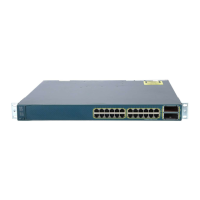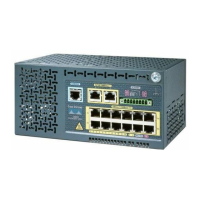15-8
Catalyst 3750 Switch Software Configuration Guide
78-16180-02
Chapter 15 Configuring Private VLANs
Configuring Private VLANs
Connecting a device with a different MAC address but with the same IP address generates a message
and the ARP entry is not created. Because the private-VLAN port sticky ARP entries do not age out,
you must manually remove private-VLAN port ARP entries if a MAC address changes.
–
You can remove a private-VLAN ARP entry by using the no arp ip-address global configuration
command.
–
You can add a private-VLAN ARP entry by using the arp ip-address hardware-address type
global configuration command.
• You can configure VLAN maps on primary and secondary VLANs (see the “Configuring VLAN
Maps” section on page 31-30). However, we recommend that you configure the same VLAN maps
on private-VLAN primary and secondary VLANs.
• When a frame is Layer-2 forwarded within a private VLAN, the same VLAN map is applied at the
ingress side and at the egress side. When a frame is routed from inside a private VLAN to an external
port, the private-VLAN map is applied at the ingress side.
–
For frames going upstream from a host port to a promiscuous port, the VLAN map configured
on the secondary VLAN is applied.
–
For frames going downstream from a promiscuous port to a host port, the VLAN map
configured on the primary VLAN is applied.
To filter out specific IP traffic for a private VLAN, you should apply the VLAN map to both the
primary and secondary VLANs.
• You can apply router ACLs only on the primary-VLAN SVIs. The ACL is applied to both primary
and secondary VLAN Layer 3 traffic.
• Although private VLANs provide host isolation at Layer 2, hosts can communicate with each other
at Layer 3.
• Private VLANs support these Switched Port Analyzer (SPAN) features:
–
You can configure a private-VLAN port as a SPAN source port.
–
You can use VLAN-based SPAN (VSPAN) on primary, isolated, and community VLANs or use
SPAN on only one VLAN to separately monitor egress or ingress traffic.
Private-VLAN Port Configuration
Follow these guidelines when configuring private-VLAN ports:
• Use only the private-VLAN configuration commands to assign ports to primary, isolated, or
community VLANs. Layer 2 access ports assigned to the VLANs that you configure as primary,
isolated, or community VLANs are inactive while the VLAN is part of the private-VLAN
configuration. Layer 2 trunk interfaces remain in the STP forwarding state.
• Do not configure ports that belong to a PAgP or LACP EtherChannel as private-VLAN ports. While
a port is part of the private-VLAN configuration, any EtherChannel configuration for it is inactive.
• Enable Port Fast and BPDU guard on isolated and community host ports to prevent STP loops due
to misconfigurations and to speed up STP convergence (see Chapter 19, “Configuring Optional
Spanning-Tree Features”). When enabled, STP applies the BPDU guard feature to all Port
Fast-configured Layer 2 LAN ports. Do not enable Port Fast and BPDU guard on promiscuous ports.
• If you delete a VLAN used in the private-VLAN configuration, the private-VLAN ports associated
with the VLAN become inactive.
• Private-VLAN ports can be on different network devices if the devices are trunk-connected and the
primary and secondary VLANs have not been removed from the trunk.
